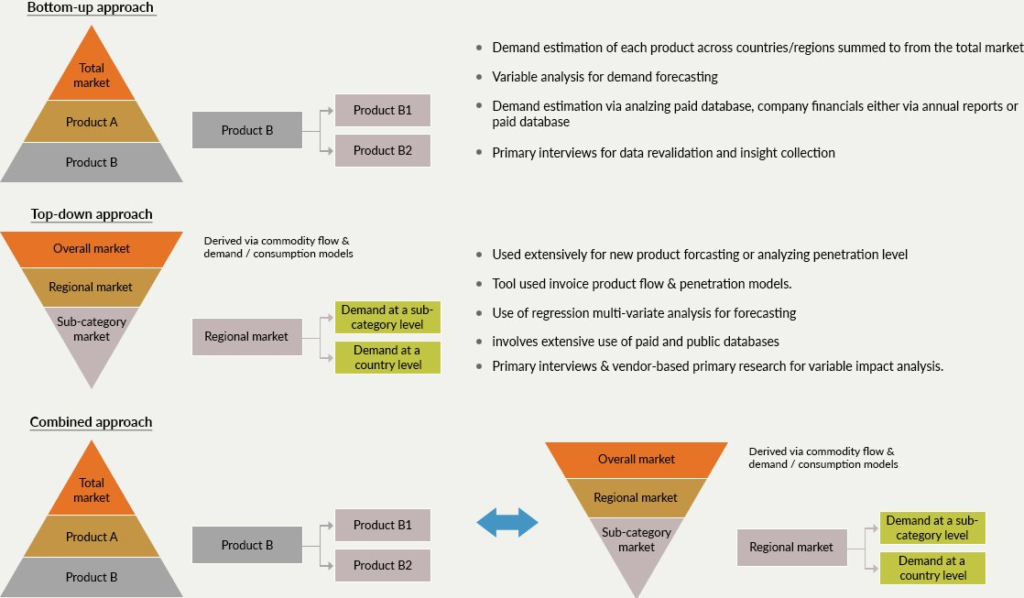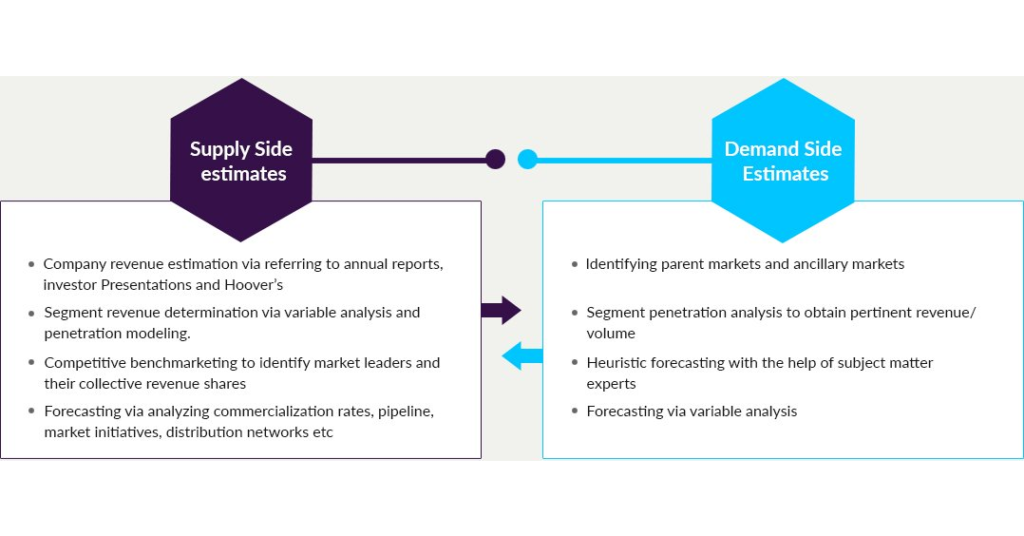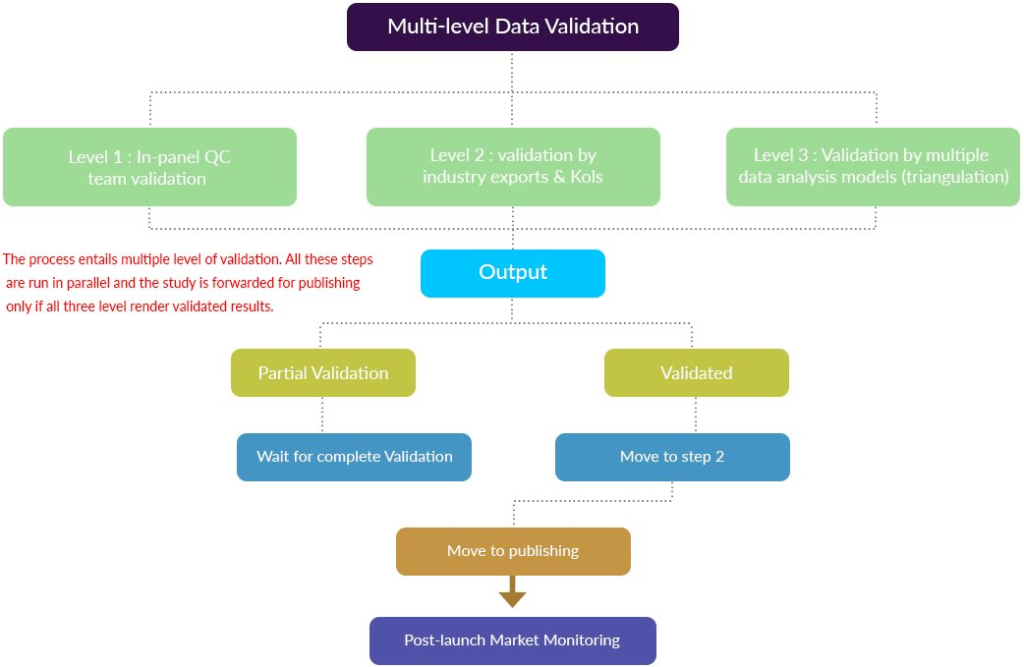Our research methodology entails an ideal mixture of primary and secondary initiatives. Key steps involved in the process are listed below:
- R.M.1. Information Procurement
The stage involves the procurement of market data or related information via different sources & methodologies.
- R.M.2. Information Analysis
This step involves the analysis & mapping of all the information procured from the previous step. It also encompasses the analysis of data discrepancies observed across various data sources.
- R.M.3. Market Formulation
The final step entails the placement of data points at appropriate market spaces in an attempt to deduce viable conclusions. Analyst perspective & subject matter expert based heuristic form of market sizing also plays an integral role in this step.
- R.M.4. Validation & Publishing
The final step entails the placement of data points at appropriate market spaces in an attempt to deduce viable conclusions. Analyst perspective & subject matter expert based heuristic form of market sizing also plays an integral role in this step. Validation is the most important step in the process. Validation & re-validation via an intricately designed process helps us finalize data-points to be used for final calculations.
Market Research Process

R.M.1. INFORMATION PROCUREMENT
The stage involves the procurement of market data or related information via different sources & methodologies.
1. Purchased Database:
- Includes company databases helps us identify financial information, industry competitive landscape, structure of the market participants. Also, it serves as an important step in market sizing, especially, in case of commodity-flow techniques.
- Industry databases, helps us gain access to industry statistics, and opinions & formulate conclusions.
- Other sources include SME journals, pertinent databases from third-party vendors to gain insights into:
- 1. Usage rates
- 2. Procedure statistics
- 3. Potential market related statistics
- 4. Information on unmet needs
- 5. Regional expenditure pattern
- 6. Investment information or opportunity based statistics
2. SCRIC’s Internal Database
- Includes our internal database of data points, collected as a result of previous research & studies and information made available via our database management team
- Also includes internal audit reports & archives.
3. Primary research
The primary interview & survey derive direction from extensive secondary research. Secondary research is a continuous process & is conducted at each level along the value chain.
- Interview with raw material, suppliers & manufactures
- Interview with manufactures, distributors, research, & representatives of regulatory bodies
- Interview with market players, industry exports, & independent consultants
R.M.2. INFORMATION OR DATA ANALYSIS
Information procured from secondary and primary initiatives are then, analyzed by using the following tools/models: (a partial list)
- Identifying variables and establishing market impact
- Establishing market trends
- Analyzing future opportunities and market penetration rates by understanding product commercialization, regional expansion etc.
- Analyzing reimbursement/regulatory trends and changes in market dynamics to establish future growth
- Analyzing sustainability strategies adhered by market participants in an attempt to determine future course of the market
- Analyzing historical market trends and super-imposing them on the current and future variables to determine year-on-year trends
- Understanding consumer base, procedure trends and regulatory framework
- Keeping a track of technological advancements in individual segments
- Base numbers are established by analyzing the following:
- 1. Company revenues and market share (this list generally includes the analysis of revenue published by publicly listed manufacturers)
- 2. Derivation of market estimates via analyzing parent and ancillary markets
The following techniques outline our research methodology:
- Model selection: demand based bottom up approach, usage rates based approach and mixed approach (top down and bottom up)
Market research approaches


- Penetration modeling for products
- 1. Determining and forecasting penetration via analyzing product features, proposed pricing, availability of internal and external substitutes etc.
- 2. Heuristic estimation of year-on-year sales by conducting primary interviews with:
- -Healthcare practitioners
- -Industry experts
- -Distributors
- 3. Product sizing and forecasting by following a diffusion model based on S-curve growth
- Analysis of current usage rates and patterns to determine substitution rates
- Regression and variable analysis
- 1. Identifying variables and assigning impact to determine growth)
- 2. QFD modeling for market share assessment (an example cited in the figure below)
- 3. Referring to historic data to establish base estimates
- 4. Using exponential smoothing for forecasting
- User size based penetration
- 1. Analyzing current needs and determining penetration to estimate market size or sales
- 2. Using unmet needs and capitalization rates to determine growth
- Trend analysis (based on year trending models)
R.M.3. MARKET FORMULATION

R.M.4. VALIDATION

OUR REPORTS
- Healthcare
- Biotechnology
- Clinical Diagnostics
- Healthcare IT
- Medical Devices
- Medical Imaging
- Pharmaceuticals

